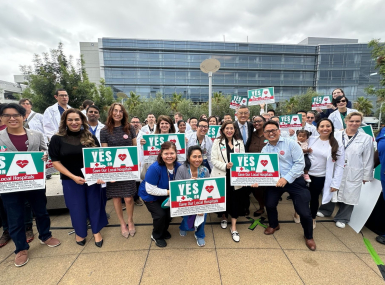Effective Treatment for Opioid Use Disorder for Incarcerated Populations: A NACo Opioid Solutions Strategy Brief

Upcoming Events
Related News
“Individuals who are incarcerated are a vulnerable population and withholding evidence-based opioid use disorder treatment increases risk of death during detainment and upon release.”
–American Society for Addiction Medicine1
What is effective treatment for opioid use disorder for people who are incarcerated?
Medication-assisted treatment (MAT) is considered the “gold standard” of care for opioid use disorder (OUD).1-3 The FDA has approved three medications for treating OUD (MOUD): methadone, buprenorphine and naltrexone.
The American Society for Addiction Medicine (ASAM) and the National Commission on Correctional Health Care (NCCHC) fully endorse treatment with MOUD in all criminal justice settings.1,4
Evidence-based OUD treatment for persons who are incarcerated consists of:
- Offering MOUD treatment initiation for those with OUD who were not receiving it prior to incarceration
- Continuing treatment with MOUD for those who were receiving it prior to incarceration
- Continuing MOUD treatment for the duration of incarceration (unless the patient requests to stop), and
- Working to prevent interruptions to MOUD treatment during intake, transfer or release.5
Treatment with MOUD can be combined with cognitive or behavioral therapy, psychiatric care or other forms of psychosocial support. Still, treatment with MOUD should be provided even in settings where these services are not available.6
What evidence supports treatment with MOUD for people who are incarcerated?
Long-term treatment with MOUD in correctional settings is safe, feasible and effective at reducing overdose deaths.7,8 Short-term use of these medications for tapers or withdrawal management is not recommended and can increase a person’s risk of overdose upon release.9,10
- Disruptions are harmful. Individuals who are forced to discontinue MOUD upon entering the justice system are significantly less likely to engage with effective treatment in the future.5
- Choice matters. Some jails provide naltrexone, but not methadone or buprenorphine, upon release. This goes against ASAM and NCCHC recommendations1,4 and is associated with increased risk of overdose11,12 and treatment drop-out.13
- Incarceration is a primary risk factor for overdose.14 In the first two weeks after release, the risk of opioid overdose is 40 times higher for those who were incarcerated compared to the general population.15 The FDA acknowledges that cessation of naltrexone treatment increases someone’s risk of overdose.16
Are there risks to my community or institution if we don’t support treatment with MOUD for people who are incarcerated?
Yes. Treatment with MOUD — specifically, with methadone or buprenorphine — is the most effective way to prevent opioid overdose among people living with OUD.17,18 Because incarceration is a known driver of opioid overdose,11 failure to provide this gold standard of care to criminal justice-involved persons may exacerbate health risks in your community.
Federal Courts have ruled that jails and prisons are bound by Title II of the Americans with Disabilities Act (ADA) and the Eighth Amendment to provide access to all three FDA-approved medications for the initiation or continuation of MOUD during incarceration.19 Failure to provide immediate and equal access to MOUD to people who are incarcerated or under community supervision may put your jurisdiction at risk of significant financial or legal liability.
Being denied MOUD while incarcerated can be painful, frightening and traumatic.
Are there best practices for providing treatment with MOUD for people who are incarcerated?
- Ensure equal access to all three FDA-approved medications so healthcare providers can reliably access the right tools for the right patients.6
- Prevent interruptions in treatment for those who were receiving MOUD prior to incarceration.5 In 2021, NACo members passed a resolution urging congress to end Medicaid’s Inmate Exclusion Policy in the Federal Social Security Act; ending this exclusion would reduce treatment interruptions in correctional settings.20
- Coordinate with local Opioid Treatment Programs (OTPs) that provide methadone. The U.S. Drug Enforcement Administration’s new “mobile methadone” rule allows community-based OTPs to dispense methadone to incarcerated persons via mobile units.21,22
- Partner with local healthcare providers to seamlessly link persons who are incarcerated or re-entering the community with long-term MOUD treatment.23,24
- Help secure funding so that county agencies and community-based service providers can cover the cost of medications for those who are un- or underinsured, as out-of-pocket cost is a common barrier to treatment with MOUD.25,26
- Fight stigma and misinformation by voicing strong support for evidence-based treatment with MOUD throughout the criminal justice system. Stigma and misinformation pose significant and persistent barriers to providing adequate treatment within the criminal justice system.27,28
What are some examples of effective treatment programs for people who are incarcerated?
Rikers Island Correctional Facility, New York City’s jail, has successfully operated a methadone and buprenorphine program since 1987. Today, the facility provides access all three FDA-approved MOUD.29
Atlantic County Justice Facility, the local jail in Atlantic County, N.J., was among the first in the nation to utilize a mobile OTP. The facility partnered with John Brooks Recovery Center, a community-based treatment facility and OTP, to provide persons incarcerated in the jail with daily methadone treatment through the Center’s mobile methadone van.30
In 2022, the Chesterfield County Jail in Chesterfield County, Va. added a MAT program to its substance use service offerings, which already included a successful abstinence-based recovery program. By creating a designated pod for persons receiving MOUD, the Supported Medically Assisted Rehabilitative Treatment (SMART) program provides continued treatment with methadone or buprenorphine for persons entering the jail as well as long-term recovery supports.31
Since 2008, the Philadelphia Department of Prisons has screened all persons entering the Curran-Fromhold Correctional Facility for OUD. Those in need of MOUD are immediately referred to the jail’s in-house MAT program, which offers all three FDA-approved MOUD. Upon release, those receiving MOUD inside the jail receive assistance obtaining health insurance, a warm hand-off to an MOUD prescriber in the community and a short-term supply of medication to “bridge” the gap between release and the first appointment with a new health care provider.32
Click the button below to watch a short video about the medication-assisted treatment program in Philadelphia’s Curran-Fromhold Correctional Facility, which begins with immediate clinical intake and ends with continued care in the community.32
Author
Jennifer J. Carroll, PhD, MPH
Dr. Carroll is a medical anthropologist, research scientist and subject matter expert on substance use and public health. She is currently an Assistant Professor of Anthropology at North Carolina State University.
Additional Resources
Implementation Guidelines and Best Practices
- National Sheriffs’ Association, “Jail-Based Medication-Assisted Treatment: Promising Practices, Guidelines, and Resources for the Field”
- U.S. Substance Abuse and Mental Health Services Administration, “Use of Medication-Assisted Treatment for Opioid Use Disorder in Criminal Justice Settings”
- American Society of Addiction Medicine, Treatment in Correctional Settings Toolkit
- Vital Strategies, “Medication-Assisted Treatment for Opioid Use Disorder in Jails and Prisons: A Planning and Implementation Toolkit”
- National Governors’ Association, “Expanding Access to Medications for Opioid Use Disorder in Corrections and Community Settings"
- Johns Hopkins Bloomberg School of Public Health, “Medications for Opioid Use Disorder in Jails and Prisons: Moving Toward Universal Access"
- U.S. Centers for Disease Control and Prevention, “Linking People with Opioid Use Disorder to Medication Treatment: A Technical Package of Policy, Programs, and Practices"
Research Reports and Issue Briefs
- American Civil Liberties Union, “Over-Jailed and Un-Treated: How the Failure to Provide Treatment for Substance Use in Prisons and Jails Fuels the Overdose Epidemic"
- The Pew Charitable Trusts, “Opioid Use Disorder Treatment in Jails and Prisons: Medication Provided to Incarcerated Populations Saves Lives"
- O’Neill Institute for National and Global Health Law at Georgetown University Law Center, “A National Snapshot: Access to Medications for Opioid Use Disorder in U.S. Jails and Prisons - Litigation, Legislation, and Policies"
Comprehensive Opioid, Stimulant, and Substance Abuse Program (COSSAP)
COSSAP is a program of the U.S. Bureau of Justice Administration that provides training and technical assistance to COSSAP grantees and other local, state and tribal authorities seeking to implement evidence-based responses to substance use within the criminal justice system.
The ORN is a technical assistance collaboration between the American Academy of Addiction Psychiatry and Columbia University. The ORN has held numerous summits and convenings on MOUD in correctional settings and has local consultants in all 50 states and 9 U.S. territories to provide education and technical assistance to communities.
State-specific Technical Assistance Programs
Many U.S. states and territories fund robust technical assistance providers to assist communities in implementing MOUD in jails, prisons, and other criminal justice settings. Examples include:
- Michigan: The Center for Behavioral Health and Justice, Wayne State University
- Washington: Office of Forensic Mental Health Services, Washington State Department of Social and Health Services
- American Society of Addiction Medicine. Public Policy Statement on Treatment of Opioid Use Disorder in Correctional Settings. Published online 2020. Accessed June 8, 2022. Available here.
- U.S. Substance Abuse and Mental Health Services Administration. TIP 63: Medications for Opioid Use Disorder. Published online 2021. Accessed June 8, 2022. Available here.
- National Academies of Sciences, Engineering, and Medicine; Health and Medicine Division; Board on Health Sciences Policy; Committee on Medication-Assisted Treatment for Opioid Use Disorder. Medications for Opioid Use Disorder Save Lives. (Mancher M, Leshner AI, eds.). National Academies Press (US); 2019. Accessed July 22, 2019. Available here.
- National Commission on Correctional Health Care. Opioid Use Disorder Treatment in Correctional Settings. National Commission on Correctional Health Care. Published 2021. Accessed June 8, 2022. Available here.
- Rich JD, McKenzie M, Larney S, et al. Methadone continuation versus forced withdrawal on incarceration in a combined US prison and jail: a randomised, open-label trial. The Lancet. 2015;386(9991):350-359. Available here.
- Substance Abuse and Mental Health Services Administration. Use of Medication-Assisted Treatment for Opioid Use Disorder in Criminal Justice Settings. Substance Abuse and Mental Health Services Administration (US); 2019. Accessed August 24, 2022. Available here.
- Green TC, Clarke J, Brinkley-Rubinstein L, et al. Postincarceration Fatal Overdoses After Implementing Medications for Addiction Treatment in a Statewide Correctional System. JAMA Psychiatry. 2018;75(4):405-407. Available here.
- Grella CE, Ostlie E, Scott CK, Dennis ML, Carnevale J, Watson DP. A scoping review of factors that influence opioid overdose prevention for justice-involved populations. Substance Abuse Treatment, Prevention, & Policy. 2021;16(1):19. Available here.
- Strang J, McCambridge J, Best D, et al. Loss of tolerance and overdose mortality after inpatient opiate detoxification: follow up study. BMJ. 2003;326(7396):959-960. Available here.
- Chang DC, Klimas J, Wood E, Fairbairn N. A Case of Opioid Overdose and Subsequent Death After Medically Supervised Withdrawal: The Problematic Role of Rapid Tapers for Opioid Use Disorder. J Addict Med. 2018;12(1):80-83. Available here.
- Ajazi EM, Dasgupta N, Marshall SW, et al. Revisiting the X: BOT Naltrexone Clinical Trial Using a Comprehensive Survival Analysis. Journal of Addiction Medicine. Published online December 3, 2021. Available here.
- Vivitrol and Overdose Risk. Published online February 2022. Accessed June 8, 2022.
- Velasquez M, Flannery M, Badolato R, et al. Perceptions of extended-release naltrexone, methadone, and buprenorphine treatments following release from jail. Addict Sci Clin Pract. 2019;14(1):37. Available here.
- Mital S, Wolff J, Carroll JJ. The relationship between incarceration history and overdose in North America: A scoping review of the evidence. Drug Alcohol Depend. 2020;213:108088. Available here.
- Ranapurwala SI, Shanahan ME, Alexandridis AA, et al. Opioid Overdose Mortality Among Former North Carolina Inmates: 2000-2015. American Journal of Public Health. 2018;108(9):1207-1213. Available here.
- Alkermes Inc. VIVITROL (naltrexone for extended-release injectable suspension) [package insert]. Published online September 2019. Accessed June 8, 2022. Available here.
- National Institutes of Health. Methadone and buprenorphine reduce risk of death after opioid overdose. National Institutes of Health (NIH). Published June 19, 2018. Accessed June 8, 2022. Available here.
- Wakeman SE, Larochelle MR, Ameli O, et al. Comparative Effectiveness of Different Treatment Pathways for Opioid Use Disorder. JAMA Network Open. 2020;3(2):e1920622. Available here.
- Legal Action Center. Cases Involving Discrimination Based on Treatment with Medication for Opioid Use Disorder (MOUD). Published online June 6, 2022. Accessed June 8, 2022. Available here.
- National Association of Counties. Resolution to Amend the Medical Inmate Exclusion Policy in the Federal Social Security Act. Published online July 12, 2021. Accessed June 8, 2022. Available here.
- U.S. Drug Enforcement Administration. DEA Finalizes Measures to Expand Medication-Assisted Treatment. DEA United States Drug Enforcement Administration. Published June 2021. Accessed June 8, 2022. Available here.
- El-Sabawi T, Baney M, Canzater SL, Weizman S. The New Mobile Methadone Rules And What They Mean For Treatment Access | Health Affairs Forefront. Health Affairs. Published August 4, 2021. Accessed June 8, 2022. Available here.
- Carroll JJ, Asher A, Krishnasamy V, Dowell D. Linking People with Opioid Use Disorder to Medication Treatment. Published online 2022. Accessed June 8, 2022. Available here.
- Prendergast ML, Hall EA, Grossman J, et al. Effectiveness of Using Incentives to Improve Parolee Admission and Attendance in Community Addiction Treatment. Crim Justice Behav. 2015;42(10):1008-1031. Available here.
- Dunphy C, Peterson C, Zhang K, Jones CM. Do out-of-pocket costs influence retention and adherence to medications for opioid use disorder? Drug Alcohol Depend. 2021;225:108784. Available here.
- McClellan C, Moriya A, Simon K. Users of retail medications for opioid use disorders faced high out-of-pocket prescription spending in 2011-2017. J Subst Abuse Treat. 2022;132:108645. Available here.
- Bandara S, Kennedy-Hendricks A, Merritt S, Barry CL, Saloner B. Methadone and buprenorphine treatment in United States jails and prisons: lessons from early adopters. Addiction. 2021;116(12):3473-3481. Available here.
- McKenzie M, Nunn A, Zaller ND, Bazazi AR, Rich JD. Overcoming obstacles to implementing methadone maintenance therapy for prisoners: implications for policy and practice. J Opioid Manag. 2009;5(4):219-227. Available here.
- Vestal C. At Rikers Island, a Legacy of Medication-Assisted Opioid Treatment. Pew Charitable Trusts. Published May 23, 2016. Accessed January 3, 2019. Available here.
- Leonard N. Inmates first in state to get mobile methadone program. Courier-Post. Published August 2017. Accessed June 8, 2022. Available here.
- King S. An escalated defense: Sheriff Karl Leonard unveils SMART program to treat inmates' opioid addiction. Published May 25, 2022. Available here.
- Advocates for Human Potential. Jail MAT Begins with Immediate Clinical Intake. YouTube. September 30, 2021. Available here.
Opioid Solutions Center
NACo's Opioid Solutions Center empowers local leaders to invest resources in effective treatment, recovery, prevention and harm reduction practices that save lives and address the underlying causes of substance use disorder.


Medication-Assisted Treatment (“MAT”) for Opioid Use Disorder: A NACo Opioid Solutions Strategy Brief
The Food and Drug Administration (FDA) has approved three medications that safely and effectively treat opioid use disorder (OUD) to improve the health and wellbeing of people living with OUD. MAT is defined by on-going, long-term treatment with one of these three medications.

Increasing Access to Evidence-Based Treatment: A NACo Opioid Solutions Strategy Brief
Our health care system’s capacity to provide medications for opioid use disorder (MOUD) falls far below the current demand for care. Only 1 in 4 people who need MOUD are able to access them. A multi-pronged approach is needed to build up the treatment workforce, create effective pathways to care and save lives.

Linkage to Care Across County Systems: A NACo Opioid Solutions Strategy Brief
As the owners and operators of systems of service that regularly interface with people affected by substance use such as hospitals, jails, courts and community colleges, counties are well positioned to link community members with evidence-based options for care, especially medications for opioid use disorder (MOUD).





